-
Countries
-
Data and Analysis
-
Special Focus
-
Crisis Responses

Contact
DTM Nigeria, iomnigeriadtm@iom.int
Language
English
Location
Nigeria
Period Covered
Jan 29 2024
Feb 04 2024
Activity
- Mobility Tracking
- Event Tracking
Between 29 January and 04 February 2024, a total of 1,578 new arrivals were recorded at locations in Adamawa and Borno states. The new arrivals were recorded at locations in Askira/Uba, Bama, Biu, Chibok, Damboa, Dikwa, Gubio, Gwoza, Kaga, Konduga, Kwaya/Kusar, Monguno and Ngala Local Government Areas (LGAs) of the most conflict-affected Borno State and in Fufore, Girei, Gombi, Guyuk, Hong, Lamurde, Madagali, Maiha, Mayo-Belwa, Michika, Mubi North, Numan, Song, Yola North and Yola South LGAs of Adamawa State.
ETT assessments identified the following movement triggers: poor living conditions (264 individuals or 17%), seasonal farming (253 individuals or 16%), military operations (239 individuals or 15%), family re-unification (229 individuals or 14%), access to humanitarian support (225 individuals or 14%), improved security (182 individuals or 12%), fear of attack (154 individuals or 10%) and attacks (32 individuals or 2%).

Contact
DTM Nigeria, iomnigeriadtm@iom.int
Language
English
Location
Nigeria
Period Covered
Jan 22 2024
Jan 28 2024
Activity
- Mobility Tracking
- Event Tracking
Between 22 and 28 January 2024, a total of 2,198 new arrivals were recorded at locations in Adamawa and Borno states. The new arrivals were recorded at locations in Askira/Uba, Bama, Damboa, Dikwa, Gubio, Gwoza, Hawul, Kaga, Kala/Balge, Mafa, Monguno and Ngala Local Government Areas (LGAs) of the most conflict-affected Borno State and in Fufore, Ganye, Girei, Gombi, Guyuk, Hong, Lamurde, Madagali, Maiha, Mayo-Belwa, Michika, Mubi North, Mubi South, Numan, Song, Yola North and Yola South LGAs of Adamawa State.
ETT assessments identified the following movement triggers: family re-unification (532 individuals or 24%), poor living conditions (517 individuals or 24%), access to humanitarian support (321 individuals or 15%), improved security (310 individuals or 14%), fear of attack (214 individuals or 10%), seasonal farming (182 individuals or 8%), military operations (113 individuals or 5%) and attacks (7 individuals or <1%).
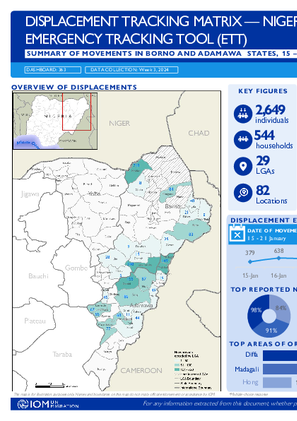
Contact
DTM Nigeria, iomnigeriadtm@iom.int
Language
English
Location
Nigeria
Period Covered
Jan 15 2024
Jan 21 2024
Activity
- Mobility Tracking
- Event Tracking
Between 15 and 21 January 2024, a total of 2,649 new arrivals were recorded at locations in Adamawa and Borno states. The new arrivals were recorded at locations in Askira/Uba, Bama, Biu, Damboa, Dikwa, Gubio, Gwoza, Hawul, Kala/Balge, Mobbar, Monguno and Ngala Local Government Areas (LGAs) of the most conflict-affected Borno State and in Fufore, Girei, Gombi, Guyuk, Hong, Lamurde, Madagali, Maiha, Mayo-Belwa, Michika, Mubi North, Numan, Song, Yola North and Yola South LGAs of Adamawa State.
ETT assessments identified the following movement triggers: poor living conditions (995 individuals or 38%), family re-unification (408 individuals or 15%), fear of attack (399 individuals or 15%), improved security (310 individuals or 12%), access to humanitarian support (260 individuals or 10%), seasonal farming (161 individuals or 6%), military operations (83 individuals or 3%) attacks (33 individuals or 1%).
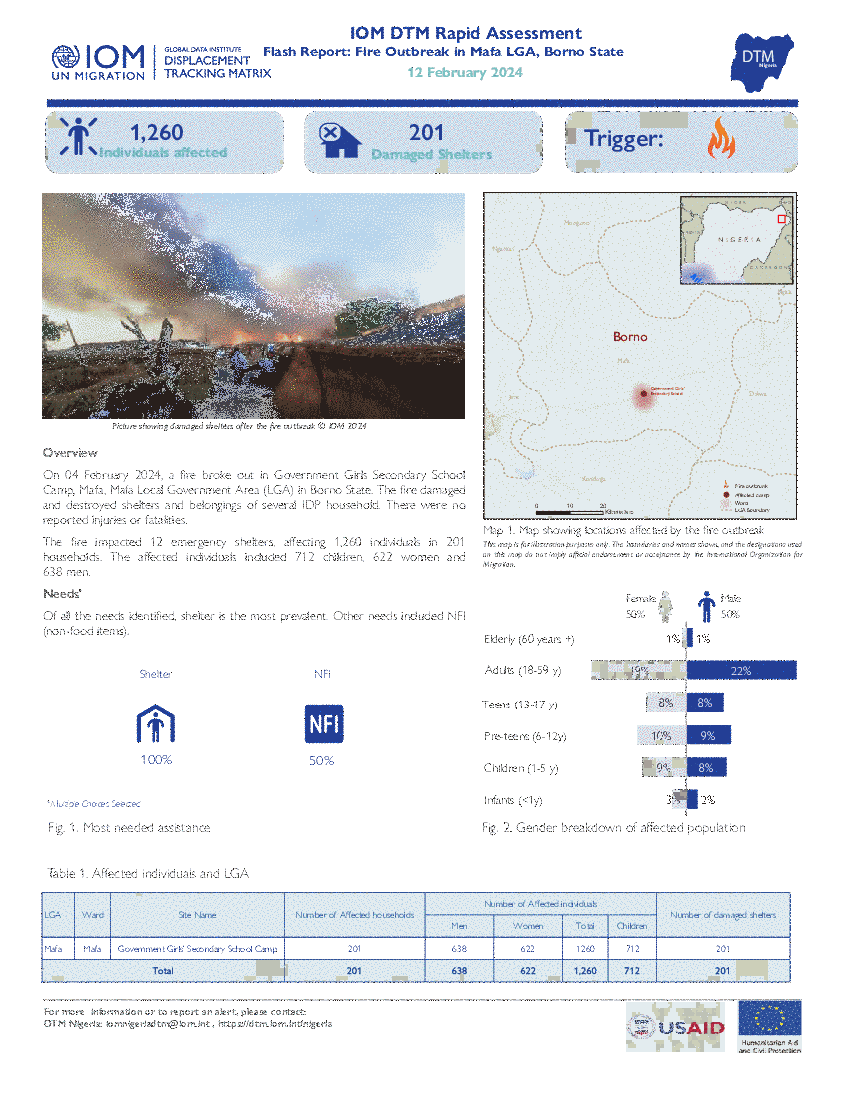
Contact
DTM Nigeria, iomnigeriadtm@iom.int
Language
English
Location
Nigeria
Snapshot Date
Feb 04 2024
Activity
- Mobility Tracking
- Event Tracking
On 04 February 2024, a fire broke out in Government Girls Secondary School Camp, Mafa, Mafa Local Government Area (LGA) in Borno State. The fire damaged and destroyed shelters and belongings of several IDP household. There were no reported injuries or fatalities.
The fire impacted 12 emergency shelters, affecting 1,260 individuals in 201 households. The affected individuals included 712 children, 622 women and 638 men.

Contact
DTM Nigeria, iomnigeriadtm@iom.int
Language
English
Location
Nigeria
Period Covered
Feb 06 2024
Feb 07 2024
Activity
- Mobility Tracking
- Event Tracking
On 06 and 07 February 2024, fires broke out in GSSSS camp Monguno, and Mashamari Kuluye camp of Konduga Local Government Area (LGA) of Borno State, which destroyed the shelters and possessions of many Internally Displaced Persons (IDPs). Many personal items have been lost in the fire, including food items and non-food items. Three fatalities were reported after the incident.
The fire destroyed 58 self-made/makeshift shelters affecting 391 individuals in 58 households. The affected individuals included 223 children, 88 women and 80 men.
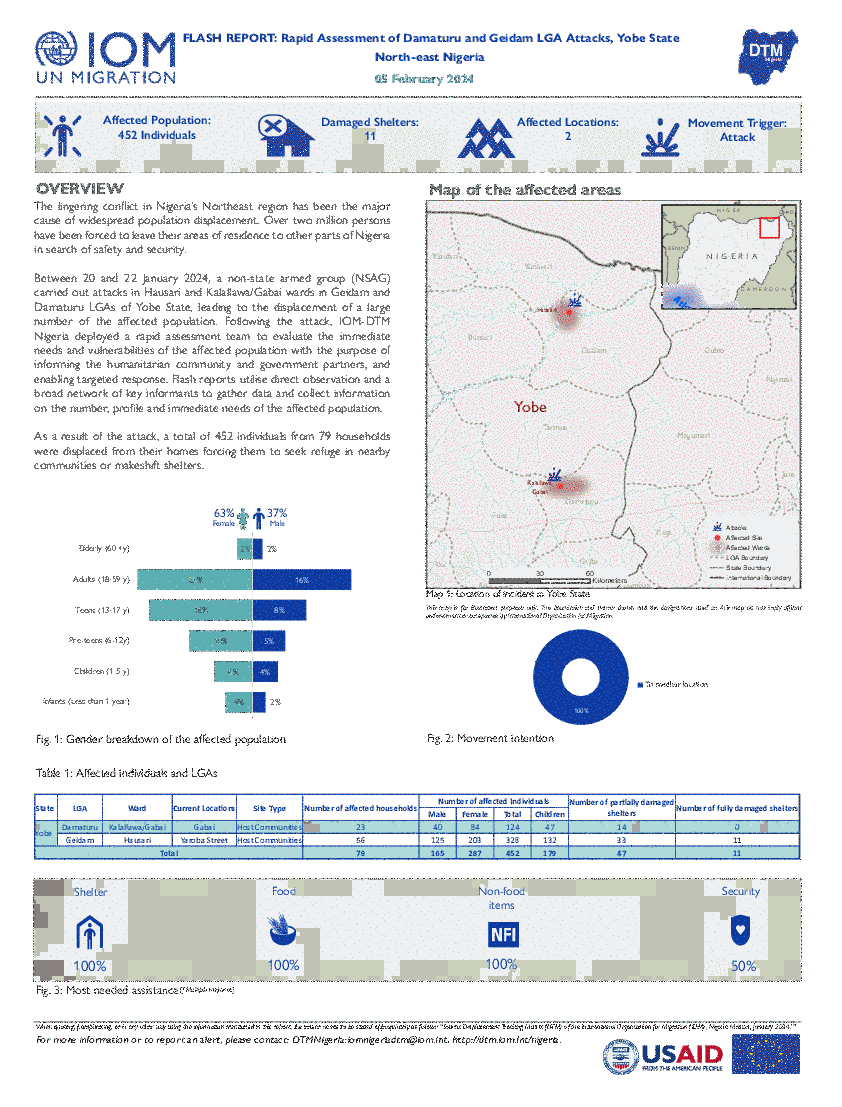
Contact
DTM Nigeria, iomnigeriadtm@iom.int
Language
English
Location
Nigeria
Period Covered
Jan 20 2024
Jan 22 2024
Activity
- Mobility Tracking
- Event Tracking
Between 20 and 22 January 2024, a non-state armed group (NSAG) carried out attacks in Hausari and Kalallawa/Gabai wards in Geidam and Damaturu LGAs of Yobe State, leading to the displacement of a large number of the affected population.
As a result of the attack, a total of 452 individuals from 79 households were displaced from their homes forcing them to seek refuge in nearby communities or makeshift shelters.

Contact
DTM Nigeria, iomnigeriadtm@iom.int
Language
English
Location
Nigeria
Snapshot Date
Jan 06 2024
Activity
- Mobility Tracking
- Event Tracking
On 6 January 2024, a Non-State Armed Group (NSAG) carried out an attack in Gujba, Asheikri and Gabir/Maduri wards in Gujba, Geidam and Damaturu LGAs of Yobe State, leading to a substantial wave of population displacement.
As a result of the attack, a total of 9,965 individuals from 1,536 households were displaced from their homes forcing them to seek refuge in nearby communities or makeshift shelters.
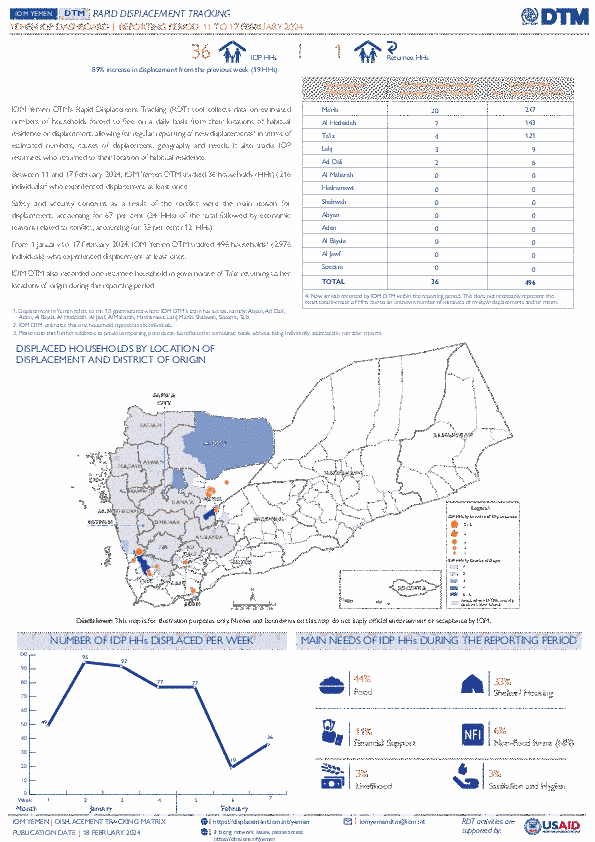
Contact
DTM Yemen, iomyemendtm@iom.int
Language
English
Location
Yemen
Period Covered
Feb 11 2024
Feb 17 2024
Activity
- Mobility Tracking
- Event Tracking
IOM Yemen DTM’s Rapid Displacement Tracking (RDT) tool collects data on estimated numbers of households forced to flee on a daily basis from their locations of origin or displacement, allowing for regular reporting of new displacements in terms of estimated numbers, geography, and needs. It also tracks returnees who returned to their location of origin.
From 1 January to 17 February 2024, IOM Yemen DTM tracked 496 households (HH) (2,976 Individuals) who experienced displacement at least once.
Between 11 and 17 February 2024, IOM Yemen DTM tracked 36 households (216 individuals) displaced at least once. The majority of people moved into/within the following governorates and districts:
- Ma’rib (20 HHs) – Ma’rib City (9 HHs), Ma’rib (8 HHs), Harib (3 HHs) districts. Most displacements in the governorate originated from Ma’rib and Sanaa.
- Al Hodeidah (7 HHs) – Hays (6 HHs), Al Khukhah (1 HHs) districts. Most displacements in the governorate were internal.
- Ta’iz (4 HHs) – Maqbanah (3 HHs), Al Qahirah (1 HHs) districts. All displacements in the governorate were internal.
The majority of people moved from the following governorates and districts:
- Al Hodeidah (9 HHs) – Hays (6 HHs), At Tuhayta (2 HHs), Al Qanawis (1 HHs) districts.
- Ta’iz (8 HHs) – Maqbanah (5 HHs), Sharab As Salam (2 HHs), Sabir Al Mawadim (1 HHs) districts.
- Ma’rib (7 HHs) – Harib (6 HHs), Majzar (1 HHs) districts.
IOM identified 56 households displaced in the previous reporting period, which covered 04 - 10 February 2024, in the governorates of Ma’rib (27 HHs), Ta’iz (20 HHs), Al Hodeidah (9 HHs). These figures have been added to the cumulative displacement total recorded since the beginning of the year.
Contact
DTM Yemen, iomyemendtm@iom.int
Location
Yemen
Activity
- Mobility Tracking
- Event Tracking
Period Covered
Feb 11 2024 -Feb 17 2024
From 1 January to 17 February 2024, IOM Yemen DTM tracked 496 households (HH) (2,976 Individuals) who experienced displacement at least once.
Between 11 and 17 February 2024, IOM Yemen DTM tracked 36 households (216 individuals) displaced at least once. The majority of people moved into/within the following governorates and districts:
- Ma’rib (20 HHs) – Ma’rib City (9 HHs), Ma’rib (8 HHs), Harib (3 HHs) districts. Most displacements in the governorate originated from Ma’rib and Sanaa.
- Al Hodeidah (7 HHs) – Hays (6 HHs), Al Khukhah (1 HHs) districts. Most displacements in the governorate were internal.
- Ta’iz (4 HHs) – Maqbanah (3 HHs), Al Qahirah (1 HHs) districts. All displacements in the governorate were internal.
The majority of people moved from the following governorates and districts:
- Al Hodeidah (9 HHs) – Hays (6 HHs), At Tuhayta (2 HHs), Al Qanawis (1 HHs) districts.
- Ta’iz (8 HHs) – Maqbanah (5 HHs), Sharab As Salam (2 HHs), Sabir Al Mawadim (1 HHs) districts.
- Ma’rib (7 HHs) – Harib (6 HHs), Majzar (1 HHs) districts.
Population Groups
Survey Methodology
Unit of Analysis Or Observation
Type of Survey or Assessment
Keywords
Geographical Scope
Administrative boundaries with available data
The current dataset covers the following administrative boundaries
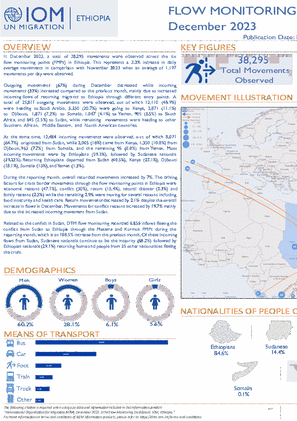
Contact
DTM Ethiopia, DTMEthiopia@iom.int
Language
English
Location
Ethiopia
Period Covered
Dec 01 2023
Dec 31 2023
Activity
- Flow Monitoring
In December 2023, a total of 38,295 movements were observed across the six flow monitoring points (FMPs) in Ethiopia. This represents a 3.2% increase in daily average movements in comparison with November 2023 when an average of 1,197 movements per day were observed.
Outgoing movements (67%) during December decreased while incoming movements (33%) increased compared to the previous month, mainly due to increased incoming flows of returning migrants to Ethiopia through different entry points. A total of 25,811 outgoing movements were observed, out of which 12,110 (46.9%) were heading to Saudi Arabia, 5,350 (20.7%) were going to Kenya, 2,871 (11.1%) to Djibouti, 1,871 (7.2%) to Somalia, 1,067 (4.1%) to Yemen, 905 (3.5%) to South Africa, and 645 (2.5%) to Sudan, while remaining movements were heading to other Southern African, Middle Eastern, and North American countries.
At the same time, 12,484 incoming movements were observed, out of which 8,071 (64.7%) originated from Sudan, while 2,005 (16%) came from Kenya, 1,350 (10.8%) from Djibouti, 963 (7.7%) from Somalia, and the remaining 95 (0.8%) from Yemen. Most incoming movements were by Ethiopians (59.3%), followed by Sudanese nationals (39.22%). Returning Ethiopians departed from Sudan (40.5%), Kenya (27.1%), Djibouti (18.1%), Somalia (13%), and Yemen (1.3%).
